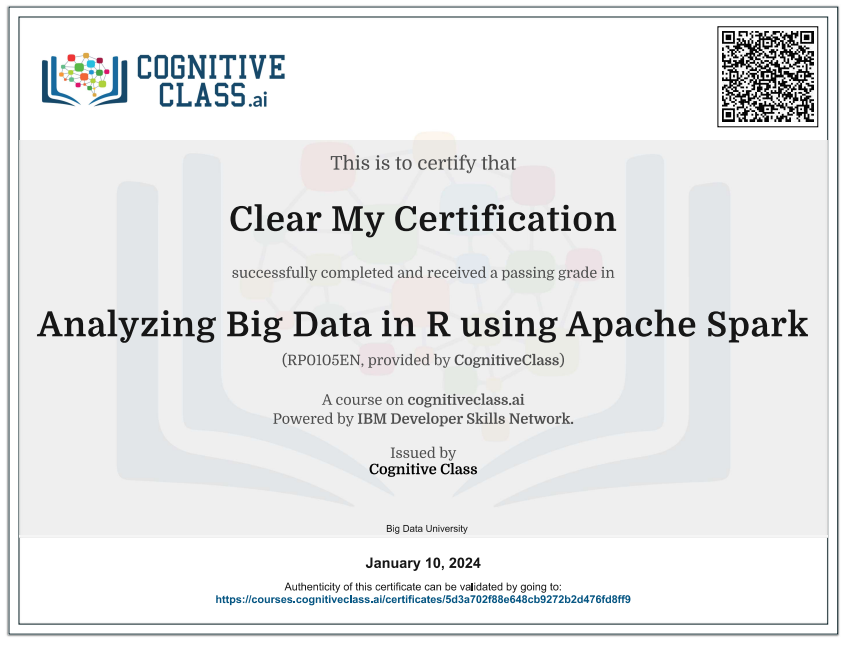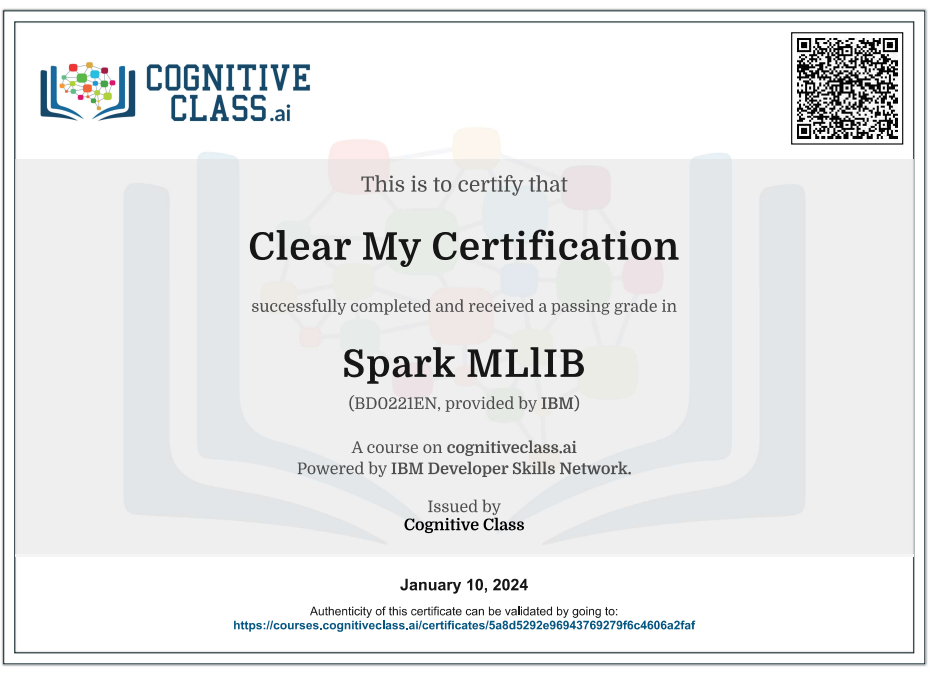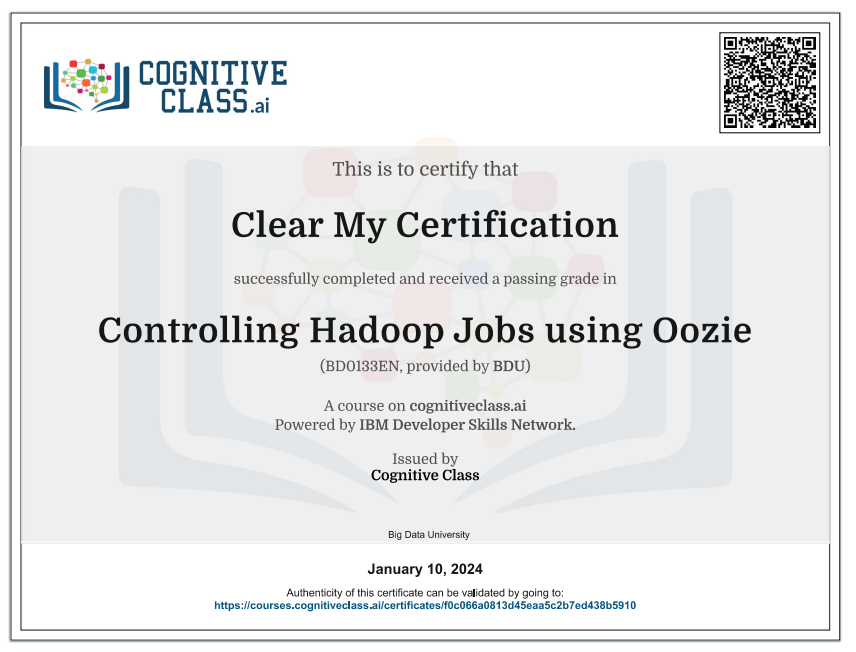Enroll Here: Predictive Modeling Fundamentals I Cognitive Class Exam Quiz Answers
Predictive Modeling Fundamentals I Cognitive Class Certification Answers

Module 1: Introduction to Data Mining Quiz Answers – Cognitive Class
Question 1: Which of the following applications would require the use of data mining? Select all that apply.
- Predicting the outcome of flipping a fair coin
- Determining which products in a store are likely to be purchased together
- Predicting future stock prices using historical records
- Determining the total number of products sold by a store
- Sorting a student database by gender
Question 2: Which of the following is NOT a section of the Modeler Interface?
- Nodes
- Palettes
- Stream Canvas
- Stream, Outputs, and Model Manager
- All of the above are sections of the Modeler Interface
Question 3: Which of the following is NOT a part of the Cross-Industry Process for Data Mining?
- Business Understanding
- Evaluation
- Data Preparation
- Data Storage
- Modeling
Module 2: The Data Mining Process Quiz Answers – Cognitive Class
Question 1: Which phase of the data mining process focuses on understanding the project requirements and objectives?
- Data Understanding
- Data Exploration
- Data Preprocessing
- Business Understanding
- Data Preparation
Question 2: Which Data Preprocessing task focuses on removing outliers and filling in missing values?
- Data Integration
- Data Cleaning
- Data Transformation
- Data Reduction
- None of the above
Question 3: The IBM SPSS Modeler supports which data type?
- Nominal
- Categorical
- Ordinal
- Continuous
- All of the above
Module 3: Modeling Techniques Quiz Answers – Cognitive Class
Question 1: Which of the following methods are commonly used for supervised learning tasks? Select all that apply.
- Neural Networks
- Decision Trees
- K-Means
- CARMA
- Regression
Question 2: Classification is a subset of supervised learning that focuses on modeling continuous variables. True or false?
- True
- False
Question 3: Which of the following algorithms is NOT supported by the SPSS Modeler?
- Logistic Regression
- CARMA
- K-Means
- Apriori
- All of the above algorithms are supported
Module 4: Model Evaluation Quiz Answers – Cognitive Class
Question 1: What is the term for a negative data point that is incorrectly classified as positive?
- True Negative
- False Positive
- True Positive
- False Negative
- None of the above
Question 2: Which of the following is NOT a cost-sensitive performance metric?
- Precision
- Accuracy
- Specificity
- Sensitivity
- All of the above metrics are cost-sensitive
Question 3: What is the formula for the precision metric?
- (False Positive) / (True Negative + True Positive)
- (True Positive) / (True Positive + False Positive)
- (False Positive) / (True Positive + False Positive)
- (True Positive) / (True Positive + False Negative)
- (True Negative) / (True Negative + False Positive)
Module 5: Deployment on IBM Bluemix Quiz Answers – Cognitive Class
Question 1: In general, the testing dataset should be significantly larger than the training dataset. True or false?
- True
- False
Question 2: Which of the following is NOT a model deployment solution?
- Bluemix
- CRISP-DM
- IBM Collaboration and Deployment Services
- SPSS Solution Publisher
- All of the above are model deployment solutions
Question 3: Which of the following statements are true of IBM Bluemix? Select all that apply.
- Bluemix generally takes about a week to deploy an app
- Bluemix is supported by a growing community
- Bluemix is closed-source
- Bluemix provides a self-service application-hosting environment
- Bluemix provides built-in load-balancing capabilities
Predictive Modeling Fundamentals I Final Exam Answers – Cognitive Class
Question 1: Which of the following suggests that the model is overfitting the data?
- High accuracy on training data and high accuracy on testing data
- Low accuracy on training data and high accuracy on testing data
- Low accuracy on training data and low accuracy on testing data
- High accuracy on training data and low accuracy on testing data
- None of the above
Question 2: Which of the following tasks would require the use of data mining?
- Predicting the outcome of rolling two fair dice
- Determining which products in a store are likely to be purchased together
- Sorting a customer database by age
- Computing the number of products sold over a given time period
- All of the above
Question 3: Suppose you have collected data on your customers and you wish to determine the demographics they fall into. Which technique is best suited for this task?
- Neural Network
- Logistic Regression
- Clustering
- Linear Regression
- Decision Tree
Question 4: Suppose you wish to use data mining in order to determine which customers are most likely to sign up for a new service. Which technique is best suited for this task?
- Apriori
- Decision Tree
- Sequence
- K-means
- CARMA
Question 5: Which SPSS Modeler node can be used to determine a model’s performance? Select all that apply.
- Evaluation Node
- Analysis Node
- Table Node
- Auto Classifier Node
- Sequence Node
Question 6: Which of the following is NOT a classification or prediction algorithm in SPSS Modeler?
- Linear Regression
- Neural Network
- Logistic Regression
- Discriminant
- Apriori
Question 7: Which SPSS Modeler node is used to specify whether a given field is an input or a target?
- Auto Classifier Node
- Data Audit Node
- Table Node
- Type Node
- Analysis Node
Question 8: Which SPSS Modeler node is useful for exploratory analysis on a data set?
- Analysis Node
- Auto Classifier Node
- Table Node
- Data Audit Node
- Evaluation Node
Question 9: Which SPSS Modeler node is used to both rename fields and exclude fields from the model?
- Restructure Node
- Filter Node
- Partition Node
- Data Audit Node
- Evaluation Node
Question 10: What is the formula for the accuracy metric? TP = true positive, TN = true negative, FP = false positive, and FN = false negative.
- TN / (TN + FP)
- TP / (TP + FN)
- TP / (TP + FP)
- (FP + FN) / (TP + TN + FP + FN)
- (TP + TN) / (TP + TN + FP + FN)
Question 11: Which major data preprocessing step focuses on feature selection and feature extraction?
- Data Integration
- Data Cleaning
- Data Reduction
- Data Audit
- Data Transformation
Question 12: Which SPSS Modeler node is used to identify missing data and screen out potentially problematic fields?
- Auto Data Preparation Node
- Auto Classifier Node
- Restructure Node
- Evaluation Node
- Data Audit Node
Question 13: SPSS Modeler provides automated tools that determine the best algorithm to use for an application. True or false?
- True
- False
Question 14: Which SPSS Modeler node is used for sampling the data set?
- Type Node
- Partition Node
- Data Audit Node
- Filter Node
- Restructure Node
Question 15: Which phase of the data mining process focuses on gathering insights about the data set?
- Data Integration
- Data Understanding
- Business Understanding
- Data Preparation
- Data Preprocessing
Introduction to Predictive Modeling Fundamentals I
Predictive modeling is a process used in statistics and machine learning to create a model that can make predictions about future outcomes based on patterns and relationships observed in historical data. Here are the fundamental steps and concepts in predictive modeling:
1. Define the Problem:
- Clearly define the problem you want to solve and the outcome you want to predict. This could be a classification problem (e.g., spam or not spam) or a regression problem (e.g., predicting house prices).
2. Data Collection:
- Gather relevant data for your predictive modeling task. Ensure that the data is representative, complete, and of high quality. Data can come from various sources, including databases, APIs, or external datasets.
3. Data Exploration and Preprocessing:
- Explore the dataset to understand its characteristics, distributions, and relationships. Handle missing values, outliers, and other anomalies. Preprocess the data by encoding categorical variables, scaling features, and splitting it into training and testing sets.
4. Feature Selection and Engineering:
- Select relevant features (variables) that contribute to the predictive task. Feature engineering involves creating new features or transforming existing ones to improve the model’s performance.
5. Choose a Model:
- Select a predictive modeling algorithm based on the nature of your problem. Common algorithms include linear regression, decision trees, support vector machines, and neural networks.
6. Model Training:
- Use the training dataset to train the selected model. The model learns patterns and relationships in the data, adjusting its parameters to minimize the difference between predicted and actual outcomes.
7. Model Evaluation:
- Assess the model’s performance using the testing dataset. Common evaluation metrics include accuracy, precision, recall, F1 score (for classification), or mean squared error (for regression). Evaluate the model’s generalization to new, unseen data.
8. Hyperparameter Tuning:
- Adjust the hyperparameters of the model to optimize its performance. This may involve using techniques like grid search or random search to find the best combination of hyperparameters.
9. Model Interpretation:
- Understand the model’s predictions and interpretability. Some models, like decision trees, offer more transparency, while others, like complex neural networks, may be more challenging to interpret.
10. Deployment:
- Deploy the trained model to a production environment to make predictions on new, real-world data. This may involve creating APIs or integrating the model into a larger software system.
11. Monitoring and Maintenance:
- Continuously monitor the model’s performance in a production environment. Retrain the model periodically with new data to adapt to changes in the underlying patterns.
12. Iterate and Improve:
- Iterate on the model and the entire predictive modeling process. As new data becomes available or as the problem evolves, refine the model and its features to improve accuracy and relevance.
Remember that predictive modeling is an iterative process, and success often comes from a combination of domain expertise, effective feature engineering, and choosing the right modeling techniques. Additionally, ethical considerations, transparency, and fairness should be taken into account throughout the modeling process.
 Clear My Certification All Certification Exam Answers
Clear My Certification All Certification Exam Answers



